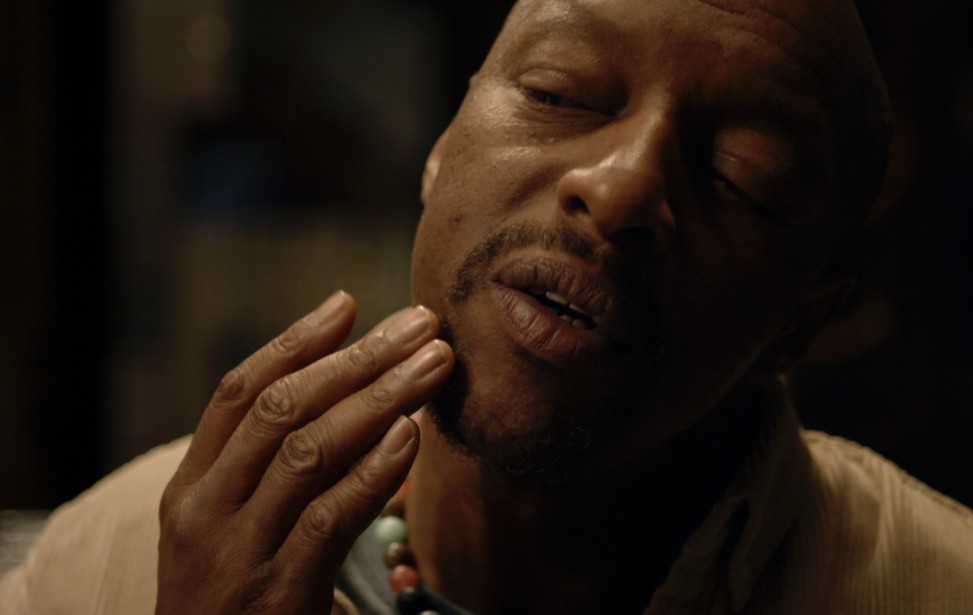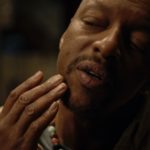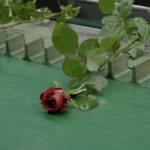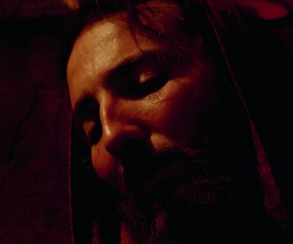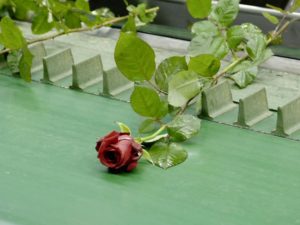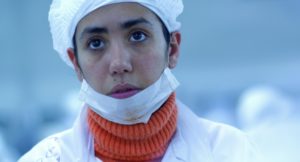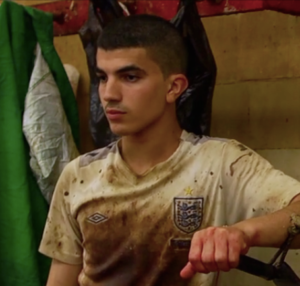Éric Baudelaire
Infinity mirrors: realities of fiction and fictive renderings of real
Éric Baudelaire’s body of work as a filmmaker is yet modest in terms of the number of films but a copious one if we trace the spectrum of ideas and styles that are carried by them. Using contemporary frames to revisit past utopic ambitions sans nostalgia, exploring experimental forms of making fiction, challenging indexicalities of text and image, using landscape as a leitmotiv for political enquiries, exploring film’s pedagogic potential and constantly expanding a form of engaged filmmaking with objective involvement- everything is part of Baudelaire’s oeuvre. Yet he insists on scaling new horizons with each new film he makes, experiencing the thrill that lies out of any convenient comfort zone.
Following the afternoon premiere of Une fleur à la bouche at the Berlinale’s Forum section, later that day I had the chance to sit down with the filmmaker and Oxmo Puccino, one of the protagonists of the film, to talk about some of the film’s key aspects- the Pirandello play that inspired it, Baudelaire’s first real tryst with (classical) drama (though ironically, his previous film was titled Un film dramatique), the political elements at play, the working process(es), the threads that run through the two seemingly disparate segments that constitute the film and his follow up to this project.
Arindam Sen
Arindam Sen : Could you perhaps briefly recall the first time you came across the Luigi Pirandello play, L’Uomo dal Fiore in Bocca (1922), and your initial impression of it? And how that eventually led to the making of this film?
Éric Baudelaire : I came across the play by Pirandello in the early 1990s while I was doing theater, briefly. I was putting on a play by Gertrude Stein on an evening when this other play by Pirandello was also performed. I remember being very struck by the text and thinking that maybe someday I would adapt this into a short film. And then I put this somewhere, at the back of my mind for thirty years. I don’t know exactly what made it emerge to the surface, I think it might have been just a free association on this idea of flowers. Three years ago someone gave me a little bit of budget to film something, the idea was very open ended and had to do with the climate crisis. It’s not a subject matter that I ever really thought about as a filmmaker and then I read an article in the New York Times about this flower market and I thought I have to go visit this place. After visiting it with Claire Mathon – my director of photography, we decided to come back and spend two days filming there, without really knowing why or how we were going to use the material. And then several months later in a subconscious kind of way, these two things came together in my mind. I think it was just a stupid wordplay initially, the two flowers – the market, the dreadful industry of flowers – at once beautiful and somewhat destructive and violent, and this flower in the man’s mouth that is killing him, Epithelioma, and I thought this was a very simple and silly proposition that I can probably put together.
AS : Since you had previously worked with mostly loose schematic structures, sometimes based on letters and correspondences, at other times assimilating footage across years before the film is born during the editing process, but never really had adapted a novel before, I wonder how was the experience different this time? More precisely, did you have to adjust the dynamics between planning and improvisation?
ÉB : In a way, each film I do is about something that is new for me. Because what interests me about cinema is learning. The films have always been an opportunity to learn something, a new aspect of filmmaking. I have never worked with text in such a way, but I have always liked text as a reader, as somebody who has been interested in literature. So there was an immediate desire and pleasure in working with a very refined version of the Pirandello play, adapting it with Anne-Louise Trividic, the screenwriter, revealing the joy of working with the words. And sure when we have this, it’s a very different way of filmmaking because the text is central, it’s in the middle of this project. So then, everything else is about serving the text, and the first part of serving the text is about finding the vehicle for it and then creating the circumstances so that the text can resonate inside of the body and the voice.
AS : [To Oxmo Puccino] How did the text impress upon you the first time you encountered it?
Oxmo Puccino : What was interesting to me, was to give life to this text. This text was ageless, without some kind of grave. I like the whole text where each word is important and it was interesting because you get different layers of interpretation. A little bit crazy, a little bit removed, a little dark. To me it was like a life lesson, to take up life on the leftover side when you know that death is close. In this period everybody is concerned, close or far, by the sickness and the impending death. The easy way then is to go into a state of depression, contrary to what happens to the character in the film.
AS : The film, at least on the surface seems to have these two fairly distinct segments, about one-third of the film is the documentary segment shot in Royal Flora Holland and then there is the fiction segment in Paris. The one connection between the two is made apparent by the title of the film itself and I could think of other metaphoric connections. What other explicitly narrative connections were you interested in?
ÉB : The first one is a very simple flower to flower analogy. The metaphor of the flower as a tumor, as a disease, is one. But then inside of the Pirandello play, a man is seeking to escape his own mortality by observing the world. It’s an obsessive kind of observation. He is observing people at work, people wrapping gifts, these are small occupations and what we are doing in the flower market is exactly that, we are observing the world and watching as people are working in this market. The film is like two mirrors facing each other, in one part it’s about simple observation and in the other, it’s about acting, text, mise-en-scène. So it’s a very radical dichotomy of what cinema can do and placing these two elements, that are completely different, together and seeing what kind of connections can exist between them.
AS : You have spoken previously about working with your editor Claire Atherton with whom you have done your last two films. There is a certain working process that you hint at, I have also read some of Atherton’s own texts elaborating on her method. Intuition seems integral but I guess the role of intuition is rather different in the working process of those two films – Also Known as Jihadi (2017) and Un Film Dramatique (2019) – and the second section of this film dealing with drama. How much so, would you for example, have considered doing retakes?
ÉB : Claire had edited fiction and documentaries with Chantal Akerman for years. I have never worked on a film that was based on a script with Claire and it’s a different process, you’re right. The way we have worked with Claire on the other films is- we have material, and we construct the film coming from that material which is something Claire talks about in her text, it’s a very intuitive relation to the material. Here it’s a very different exercise, there’s a script, which has to be followed and then there are different propositions that the actors have made during the evening, each night when we are filming. But there is still intuition and sensation involved in editing. We were looking at different takes and there will be this one take with Oxmo which would really resonate with us stronger than the other takes. And the film is just constructed by the way of putting all of these moments that have the strongest resonance together, the architecture of the film is based on this. I remember this one take at the very end where there is a small mistake but it’s the best take. Oxmo forgot one word and he says it at the end and you feel like maybe it was a mistake but the take itself, it’s the last take in the bar, is so beautiful that we thought about this and decided that it doesn’t matter that there is a mistake in there. Even though the script provides the structure, it’s always about this sensation and intuition that you get from watching the rushes. And we would never do a retake, that’s contrary to how we both think about cinema. Claire has taught me this- you make the film with what you have and it will always be ok. I think there is a consumerist mentality in doing retakes, most of the time when people do retakes, they don’t really need them. It’s more of an assurance than a necessity. Unless there was an accident or something.
AS : You are a visual artist who has previously exhibited work both in a gallery/museum context as well as in the single-screen cinema context. Part of the footage included in the film here has previously been shown as a multi-channel work at Kunst Halle Sankt Gallen in Switzerland. What in your assessment are the site-specific challenges of these two contexts especially in relationship to this work?
ÉB : It’s the first time I made two different versions of the film, I have never done this before. I have always imposed the cinema kind of film inside of the exhibition. And it was an interesting experience because we made a very different object. In one case, the single-channel film seen here has all the dialogue, the exhibition version has no dialogue, so we have cut out 35 minutes of film, thrown it away and what we added is four other screens which gives a tremendously spatial sensation. So it multiplies the feeling of being inside this flower distribution. The part in the bar was taken out of the exhibition version, but everything else, walking around in the streets, the scenes that come after the bar is in there. We used to joke about it, the exhibition is about the night when he didn’t go to the bar.
It becomes more intimate in the street scenes where the character is walking around Paris and observing. So the exhibition version is more about space whereas the cinema version is more about time. And it was interesting to see that both space and time are contained in the material.
AS : One is compelled to ruminate on the nature of labor, the scale of the global trade of cut flowers and how the dynamics of production is evolving over the years in the first segment. However the political dimension of this film is still rather diffuse compared to some of your previous films. Would you consider this as somewhat of a departure from frontally dealing with political subjects?
ÉB : I think it’s complicated to know whether something is a departure when you are the maker. It’s not a departure in the sense that it’s always a continuation of the last problem that you had. Or it’s always the extension of the last question that you weren’t able to answer. So in that sense it’s never a departure because you’re the one constructing this path and the path is what it is. I think that it is just differently political because it’s about personal politics of dealing with death and how you live your life as an observer of work, of material situations and the ways of processing the finite number of days that are in front of you. It’s political in the sense that it deals with consumption and environmental questions that have never been central to my practice. But it’s true that they are brought into a film in a very different way than sort of the explicitly political concerns of some of the other films. So there is certainly a different way of bringing the political question into the film but it’s there in all of these small ways.
AS : The first segment also imparts a sense that the documentary aspects are fragmented in a way such that they seem like vignettes from an unfulfilled narrative arc.
ÉB : When we arrived with Claire Mathon in this space, the flower market, I realized that it was one of the first places where for things that I am trying to film, I had no need for language, and it was a very exciting thing. I could spend some time there and film something that’s big- ecologically/economically/politically and I wouldn’t have to explain anything. And the way we chose to film it was- we have to make every character into something. In a documentary sense, we are not filming a process, we are filming characters. So if we arrive at a station and somebody was working on a machine, how would you film them as if you were in a fiction film? What’s the distance so that they become a character in narrative fiction? There is a certain distance and then there are close up shots of the hands. We are trying to film the documentary material with the fiction eye.
AS : Do you perceive this as a project that you will move on from or do you want to come back to it in a different form?
ÉB : I am writing another project which is basically taking the flowers and extending that to an eight hour movie about processes that are all over the world, without words, without any explanations. I am very interested in that, that is something that I am thinking about. Just continuing this pure observation but making it into some kind of gigantic indigestible large film.
